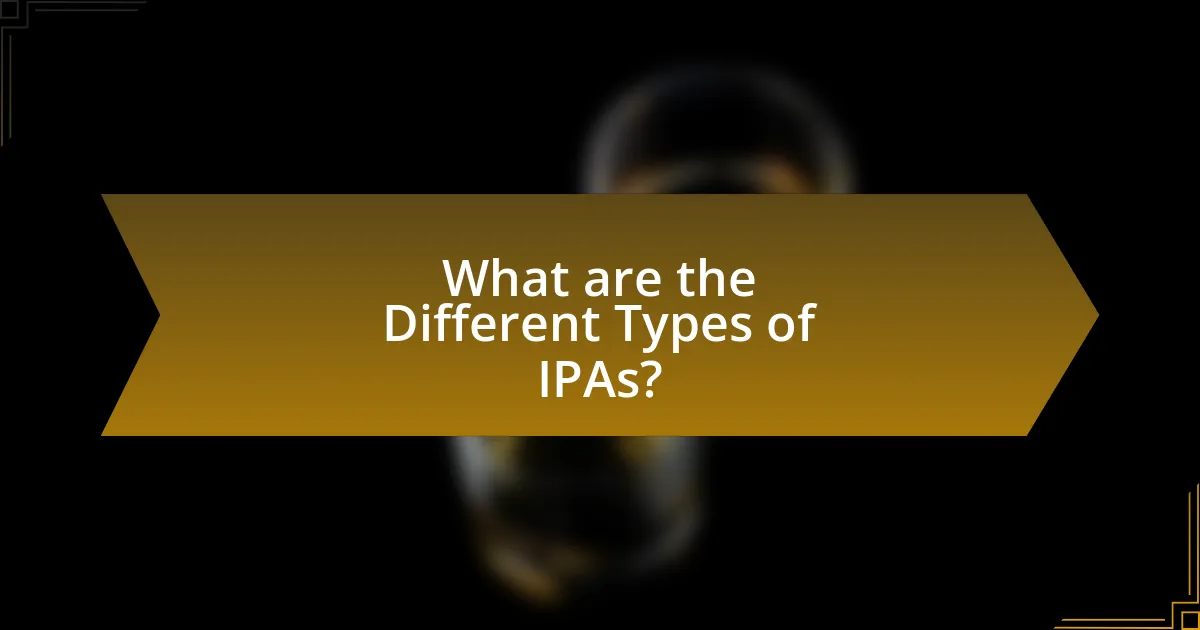India Pale Ales (IPAs) are a prominent beer style known for their strong hop flavors and higher alcohol content, typically ranging from 5.5% to 7.5% ABV. This article explores the origins and evolution of IPAs, tracing their roots back to British colonial times and their rise in popularity during the craft beer movement. It examines the various types of IPAs, including American, New England, and Double IPAs, highlighting their distinct flavor profiles and brewing techniques. Additionally, the article addresses consumer preferences, the impact of the craft beer movement, and best practices for selecting and enjoying IPAs, providing a comprehensive overview of this influential beer style.

What are IPAs and Why are They Popular?
IPAs, or India Pale Ales, are a style of beer characterized by their strong hop flavor and higher alcohol content, typically ranging from 5.5% to 7.5% ABV. Their popularity stems from the bold and diverse flavors they offer, which can include citrus, pine, and floral notes, appealing to craft beer enthusiasts. The rise of the craft beer movement in the late 20th century significantly contributed to the IPA’s popularity, with breweries experimenting with various hop varieties and brewing techniques. According to the Brewers Association, IPAs accounted for over 40% of the craft beer market share in 2020, highlighting their dominance and consumer preference in the beer industry.
How did IPAs originate and evolve over time?
IPAs, or India Pale Ales, originated in the late 18th century as a result of British brewers exporting pale ales to India. The long journey required higher hop content for preservation, leading to the creation of a hoppier beer style. Over time, IPAs evolved through various regional adaptations, particularly in the United States, where craft brewers began experimenting with different hop varieties and brewing techniques in the late 20th century. This evolution resulted in diverse substyles, such as West Coast IPAs, New England IPAs, and Double IPAs, each characterized by unique flavor profiles and aromas. The rise of the craft beer movement significantly contributed to the popularity and innovation of IPAs, making them a dominant style in the modern beer landscape.
What historical events contributed to the rise of IPAs?
The rise of India Pale Ales (IPAs) can be attributed to several historical events, primarily the British colonial expansion in the 18th and 19th centuries. During this period, British brewers began to produce stronger, hoppier beers to withstand the long sea voyages to India, where British expatriates resided. The use of hops acted as a natural preservative, allowing the beer to survive the journey.
Additionally, the introduction of pale malt and advancements in brewing technology during the Industrial Revolution further enhanced the production of IPAs. The first recorded mention of the term “India Pale Ale” dates back to 1823, solidifying its identity. The popularity of IPAs surged in the late 20th century, particularly in the craft beer movement of the 1980s and 1990s, as brewers sought to create bold, flavorful beers that distinguished themselves from mass-produced lagers.
These historical developments collectively contributed to the emergence and enduring popularity of IPAs in the global beer market.
How have brewing techniques changed since the inception of IPAs?
Brewing techniques have evolved significantly since the inception of IPAs, primarily through advancements in hop utilization, fermentation processes, and ingredient sourcing. Initially, IPAs were brewed using traditional methods that emphasized long boil times to extract bitterness from hops, often resulting in a less aromatic beer. Modern brewing techniques now include methods such as dry hopping, which adds hops during fermentation to enhance aroma without increasing bitterness. Additionally, the introduction of new yeast strains has improved fermentation efficiency and flavor profiles, allowing for a wider range of IPA styles. The use of advanced brewing technology, such as temperature control and automated systems, has also streamlined the brewing process, ensuring consistency and quality in the final product. These changes reflect a broader trend in the craft beer industry towards innovation and experimentation, leading to the diverse array of IPAs available today.
What distinguishes IPAs from other beer styles?
IPAs, or India Pale Ales, are distinguished from other beer styles primarily by their strong hop flavor and aroma, which is significantly more pronounced than in most other beers. This characteristic is due to the use of a higher quantity of hops during brewing, which contributes to the beer’s bitterness, floral, citrus, and piney notes. Additionally, IPAs often have a higher alcohol content, typically ranging from 5.5% to 7.5% ABV, compared to many other beer styles. The emphasis on hop-forward profiles in IPAs is rooted in their historical context, as they were originally brewed in England for export to India, necessitating the use of hops as a preservative.
What are the key flavor profiles of IPAs?
The key flavor profiles of IPAs include hoppy bitterness, citrus, pine, floral, and tropical fruit notes. These flavors primarily stem from the use of various hop varieties, which contribute to the beer’s aroma and taste. For instance, hops like Cascade and Citra impart strong citrus and tropical fruit characteristics, while varieties such as Simcoe and Amarillo add pine and floral elements. The bitterness level in IPAs typically ranges from moderate to high, often measured in International Bitterness Units (IBUs), which can exceed 60 in many examples. This combination of flavors creates a complex and refreshing drinking experience that is characteristic of the IPA style.
How do the ingredients in IPAs affect their taste?
The ingredients in IPAs significantly influence their taste by contributing to bitterness, aroma, and flavor complexity. Hops, the primary ingredient, impart bitterness through alpha acids, which balance the sweetness of the malt. Different hop varieties provide distinct aromas and flavors, ranging from citrus and pine to floral and herbal notes. Malt contributes sweetness and body, with darker malts adding caramel or roasted flavors. Yeast also plays a role, as different strains can produce fruity esters or spicy phenols, further enhancing the overall taste profile. For example, a study published in the Journal of the American Society of Brewing Chemists highlights that the choice of hops and malt directly correlates with the sensory characteristics of the final beer, confirming the critical role of these ingredients in shaping the taste of IPAs.
Why do craft beer enthusiasts gravitate towards IPAs?
Craft beer enthusiasts gravitate towards IPAs primarily due to their bold hop flavors and aromas. IPAs, or India Pale Ales, are characterized by a higher hop content, which results in a diverse range of taste profiles, from citrusy and floral to piney and resinous. This variety appeals to craft beer drinkers who seek unique and complex flavor experiences. Additionally, the craft beer movement has popularized IPAs, with statistics showing that they account for a significant portion of craft beer sales, reflecting their widespread popularity among consumers.
What role does the craft beer movement play in IPA popularity?
The craft beer movement significantly enhances IPA popularity by promoting innovation and diversity in brewing. This movement has led to a surge in small, independent breweries that experiment with various hop varieties and brewing techniques, resulting in a wide range of IPAs that cater to diverse consumer tastes. According to the Brewers Association, craft breweries produced over 23 million barrels of IPA in 2020, reflecting a 10% increase from the previous year, which underscores the growing consumer demand for this style. The craft beer movement’s emphasis on quality, unique flavors, and local sourcing has made IPAs a flagship style, further solidifying their popularity among beer enthusiasts.
How do IPAs cater to diverse consumer preferences?
IPAs cater to diverse consumer preferences by offering a wide range of flavor profiles, alcohol content, and brewing techniques. The variety includes styles such as West Coast IPAs, which are known for their hoppy bitterness and citrus notes, and New England IPAs, which emphasize juiciness and a hazy appearance. Additionally, breweries often experiment with different hop varieties and adjuncts, allowing for unique combinations that appeal to different taste preferences. According to the Brewers Association, the IPA category accounted for over 40% of craft beer sales in 2020, highlighting its popularity and the ability to satisfy various consumer tastes.

What are the Different Types of IPAs?
The different types of IPAs include American IPA, New England IPA, West Coast IPA, Double IPA, and Session IPA. American IPA is characterized by its strong hop flavor and aroma, often with a balanced malt backbone. New England IPA, known for its hazy appearance, features a juicy, fruity hop profile with low bitterness. West Coast IPA is typically clear and has a more pronounced bitterness, showcasing pine and citrus notes. Double IPA, or Imperial IPA, has a higher alcohol content and intensified hop flavors. Session IPA is designed to be lower in alcohol while maintaining hop-forward characteristics, making it easy to drink in larger quantities. These classifications reflect the diverse brewing styles and flavor profiles within the IPA category.
What are the main categories of IPAs?
The main categories of IPAs are American IPA, New England IPA, Double IPA, Session IPA, and Black IPA. American IPA is characterized by its strong hop flavor and bitterness, often featuring citrus and pine notes. New England IPA, known for its hazy appearance, emphasizes juicy hop flavors with a softer mouthfeel. Double IPA, or Imperial IPA, has a higher alcohol content and intense hop profile. Session IPA is designed to be lower in alcohol while maintaining hop characteristics, making it easy to drink. Black IPA combines the hoppy qualities of an IPA with roasted malt flavors, resulting in a unique dark beer experience.
How do American IPAs differ from English IPAs?
American IPAs are characterized by a stronger hop flavor and aroma compared to English IPAs, which tend to emphasize maltiness and balance. The use of American-grown hops in American IPAs results in more pronounced citrus, pine, and tropical fruit notes, while English IPAs typically feature earthy and floral hop characteristics from traditional English hop varieties. Additionally, American IPAs often have a higher alcohol content, usually ranging from 5.5% to 7.5%, whereas English IPAs generally fall between 4.5% and 6.5%. This distinction in hop usage and alcohol content highlights the regional brewing styles and preferences that define each type of IPA.
What defines a New England IPA compared to a West Coast IPA?
A New England IPA is defined by its hazy appearance, juicy flavor profile, and low bitterness, while a West Coast IPA is characterized by its clear appearance, pronounced hop bitterness, and piney or citrusy flavors. The haziness in New England IPAs comes from the use of certain grains and yeast, which contribute to a smooth mouthfeel and fruity aromas, often featuring tropical fruit notes. In contrast, West Coast IPAs utilize a more aggressive hopping technique, resulting in a crisp finish and a more pronounced bitterness, typically showcasing resinous and floral hop characteristics. This distinction is supported by brewing trends and consumer preferences that have emerged since the early 2000s, with New England IPAs gaining popularity for their approachable taste and aroma.
What unique characteristics do specialty IPAs possess?
Specialty IPAs possess unique characteristics such as innovative hop varieties, distinct flavor profiles, and often experimental brewing techniques. These IPAs frequently showcase uncommon hops that impart unique aromas and tastes, ranging from tropical fruit to herbal notes. Additionally, specialty IPAs may utilize unconventional ingredients or methods, such as dry hopping or barrel aging, to enhance complexity and depth. This experimentation leads to a diverse range of flavors and aromas that differentiate them from traditional IPAs, making them appealing to craft beer enthusiasts seeking novel experiences.
How do Double and Triple IPAs enhance the IPA experience?
Double and Triple IPAs enhance the IPA experience by offering higher alcohol content and intensified hop flavors. These styles typically feature a greater amount of hops, resulting in more complex aromas and flavors, such as citrus, pine, and tropical fruit. For instance, Double IPAs generally have an alcohol by volume (ABV) of 7.5% to 10%, while Triple IPAs can exceed 10% ABV, which contributes to a richer mouthfeel and a more robust taste profile. The increased hop usage not only amplifies bitterness but also enhances the aromatic qualities, making the drinking experience more vibrant and layered.
What are the defining traits of Session IPAs?
Session IPAs are characterized by their lower alcohol content, typically ranging from 3% to 5% ABV, which allows for easy drinking over extended periods. These beers maintain a hoppy flavor profile similar to traditional IPAs, featuring prominent citrus, floral, and pine notes, but with a lighter body and a crisp finish. The balance between hop bitterness and malt sweetness is crucial, ensuring that the beer remains refreshing without overwhelming the palate. This style caters to drinkers seeking flavorful options without the higher alcohol levels found in standard IPAs, making them ideal for social settings and prolonged enjoyment.

How to Choose and Enjoy IPAs?
To choose and enjoy IPAs, first identify your flavor preferences, such as hoppy, fruity, or malty characteristics. IPAs, or India Pale Ales, are known for their strong hop flavors, which can vary significantly between different styles like West Coast, New England, or Double IPAs. For instance, West Coast IPAs typically feature a more bitter and piney profile, while New England IPAs are often hazy and juicy with tropical fruit notes.
Next, consider the alcohol by volume (ABV) and bitterness units (IBU) of the IPA; higher ABV and IBU can indicate a stronger flavor and bitterness, which may appeal to seasoned craft beer drinkers. Additionally, explore local breweries or craft beer shops to sample a variety of IPAs, as fresh beer often provides the best flavor experience.
Finally, enjoy IPAs at the right temperature, usually between 45°F to 55°F, to enhance their aromatic qualities. Pairing IPAs with food, such as spicy dishes or rich cheeses, can also elevate the tasting experience, as the hops can complement or contrast with various flavors.
What factors should you consider when selecting an IPA?
When selecting an IPA, consider the flavor profile, alcohol content, and hop variety. The flavor profile determines the taste experience, which can range from fruity and floral to bitter and piney, influenced by the specific hops used. Alcohol content typically varies between 5% to 7.5%, affecting the beer’s strength and overall drinking experience. Additionally, different hop varieties contribute unique aromas and flavors, such as citrus, tropical fruit, or herbal notes, which can significantly impact your preference. Understanding these factors will help you choose an IPA that aligns with your taste and desired drinking experience.
How does the ABV influence your choice of IPA?
The Alcohol by Volume (ABV) significantly influences the choice of an IPA by determining its strength and flavor profile. Higher ABV IPAs, typically above 7%, often present bolder flavors and a more pronounced hop character, appealing to those seeking a robust experience. Conversely, lower ABV IPAs, around 4-6%, tend to be more sessionable, offering a lighter taste that is easier to drink over extended periods. This distinction is crucial as it aligns with consumer preferences for either intense flavor or drinkability, supported by the fact that many craft beer enthusiasts often select IPAs based on their desired drinking experience and occasion.
What role does the hop variety play in flavor selection?
The hop variety significantly influences flavor selection in brewing, as different hop types impart distinct aromatic and taste characteristics. For instance, varieties like Citra and Mosaic are known for their citrus and tropical fruit notes, while others like Cascade offer floral and piney flavors. The specific compounds present in each hop variety, such as alpha acids and essential oils, determine the resulting flavor profile in the final beer product. Research indicates that the choice of hop variety can alter the sensory experience of the beer, affecting both aroma and bitterness, which are crucial for the overall flavor balance in IPAs.
What are the best practices for tasting and pairing IPAs?
The best practices for tasting and pairing IPAs include evaluating the beer’s aroma, flavor, and mouthfeel while considering complementary food pairings. First, when tasting an IPA, one should focus on the aroma by swirling the glass and inhaling deeply to identify hop characteristics, which can range from citrus to pine. Next, take a sip to assess the flavor profile, noting the balance between bitterness and malt sweetness. The mouthfeel should also be considered, as IPAs can vary from light and crisp to thick and creamy.
For food pairings, IPAs generally complement spicy dishes, grilled meats, and rich cheeses due to their hoppy bitterness and carbonation, which can cut through fat and enhance flavors. For example, pairing a West Coast IPA with spicy tacos can elevate the meal by balancing heat with the beer’s bitterness. Additionally, a fruity New England IPA pairs well with creamy desserts, as the sweetness of the beer can enhance the dish’s flavors. These practices ensure a more enjoyable tasting experience and highlight the unique characteristics of IPAs.
How can you enhance your tasting experience with food pairings?
To enhance your tasting experience with food pairings, select complementary flavors that elevate both the food and the IPA. For instance, pairing a citrusy IPA with spicy dishes can balance heat and enhance the beer’s hoppy notes, while a malty IPA can complement rich, savory foods like grilled meats. Research indicates that specific flavor combinations can create a more enjoyable tasting experience, as seen in studies on flavor interactions, which show that certain pairings can enhance perceived flavors and aromas.
What tips can help you appreciate the nuances of different IPAs?
To appreciate the nuances of different IPAs, focus on tasting a variety of styles, such as West Coast, New England, and Session IPAs, as each offers distinct flavor profiles. For instance, West Coast IPAs are known for their clear appearance and strong hop bitterness, while New England IPAs are characterized by their hazy look and juicy, fruity flavors. Additionally, pay attention to the aroma by swirling the glass to release the hops’ scents, which can reveal citrus, pine, or floral notes. Understanding the ingredients, such as the types of hops and malts used, also enhances appreciation; for example, Citra hops impart tropical fruit flavors, while Mosaic hops add complexity with earthy and herbal notes. Finally, consider the brewing process, as variations in fermentation and dry hopping can significantly affect the final taste.
What are some common misconceptions about IPAs?
Common misconceptions about IPAs include the belief that all IPAs are extremely bitter and that they are exclusively high in alcohol content. While many IPAs do have a noticeable bitterness due to the hops used, there are various styles, such as New England IPAs, which can be quite juicy and less bitter. Additionally, the alcohol content in IPAs can vary widely; some are lower in alcohol, around 4-5%, while others can reach higher levels, but not all IPAs are strong. This diversity in flavor profiles and alcohol content demonstrates that IPAs are not a monolithic category but rather encompass a range of styles and characteristics.
How can understanding these misconceptions improve your IPA experience?
Understanding misconceptions about IPAs can significantly enhance your IPA experience by allowing you to make informed choices and appreciate the nuances of different brews. For instance, recognizing that not all IPAs are overwhelmingly bitter can lead you to explore a wider variety of flavors, such as fruity or floral notes, which are often present in New England IPAs. Additionally, understanding the role of hop varieties and brewing techniques can deepen your appreciation for the craftsmanship involved, leading to a more enjoyable tasting experience. This knowledge empowers you to select IPAs that align with your personal taste preferences, ultimately enriching your overall enjoyment of the style.
